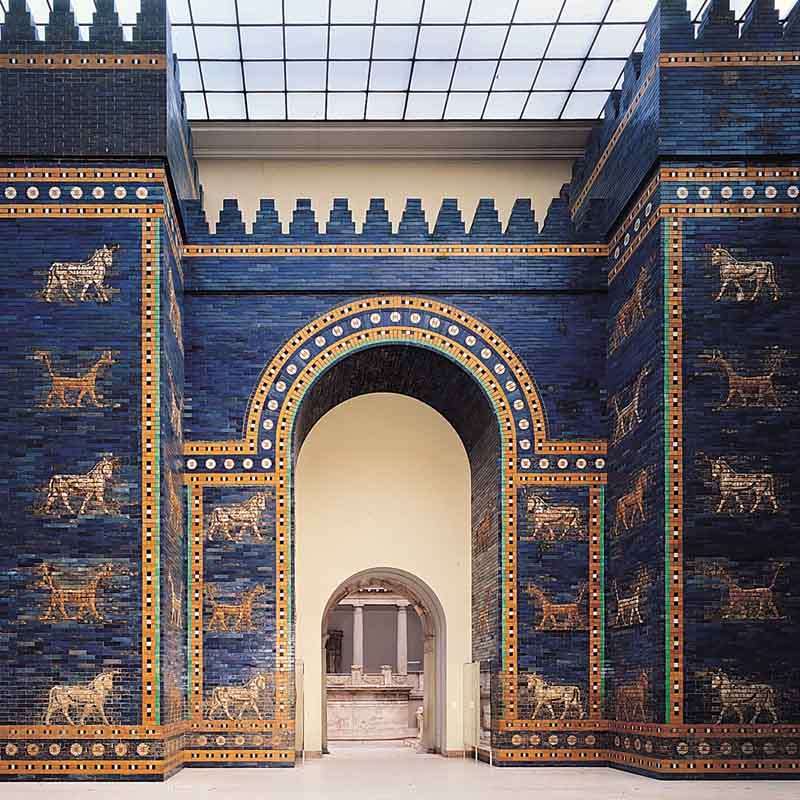Honoring History: The World’s Earliest Mosaic art from Mesopotamia

If you’re avoiding that mosaic art you’ve always wanted in your home because you’re worried about whether or not it will go out of style, fear not: as history tells us, the mosaic art form is one of the most timeless, as its beauty has been celebrated over the past several millennia. Why should we look so far back in time? On the one hand, it reassures us that the field of mosaic design will forever be a perennial favorite. On the other, it allows us to mine the past for mosaic ideas that we can revive in the present . . . talk about timeless!
The Incredible Ishtar Gate
The earliest ancestors of the mosaic tradition emerged in decorative designs of ancient Mesopotamia around the 6th century B.C. It was during this era that innovative artists began experimenting with glazed bricks as a means of creating dazzling façades. One of the best examples of this tradition is the brickwork that once adorned one of the entry gates, known as the Ishtar Gate, to the ancient city of Babylon (in present-day Iraq), once the home of the famous Hanging Gardens once included among the Seven Wonders of the Ancient World.
Alluding to the sumptuous gardens held inside, the Ishtar Gate was bedecked with incredibly splendid glazed bricks that featured vibrantly colored animalistic motifs, including lions and oxen, enveloped by a rich blue background conjured through ground lapis lazuli, one of the most coveted semi-precious stones of the ancient world. The brilliant glazing, combined with the bas-relief work that allows the animals to actually emerge from the brick’s surface, resulted in an entryway that was sure to captivate all visitors to Babylon.
The Dazzle of Darius
Nearly simultaneously, a similar approach to decoration emerged within the palaces of ancient rulers. King Darius I, for example, ruler of the ancient Persian Empire, incorporated a wide variety of opulent glazed brick designs into his palace at Susa (in present-day southwestern Iran). These narrative programs were designed to reflect his authority as a ruler as well as his wealth, inspiring awe among those who took audience with him as they navigated his glimmering corridors.
Contemporary Connections
These early ancestors of the mosaic field might seem very distant from the mosaics we know and admire today, but it is in these early motifs that we find the root of the tradition. The notion of manipulating the surface of the brick face in essence foreshadowed the notion of intricate tile work and glimmering and seemingly bejeweled surfaces that are desired in today’s mosaics.
So, what can be gained from a look to these Mesopotamian masterpieces? These examples reveal that even the simplest pop of color in a glazed context can enliven – and even embolden – an interior. A glazed tile mosaic offers a unique depth and richness of color that is unmatched by other tile options, adding an immediate warmth and elegance to the interior it shares. In short, you don’t need to be overwhelmed with a mosaic featuring meticulous tesserae work; an equally compelling entrée into the world of mosaics can be achieved with straightforward rectangular or square tiles that boast brilliant color.
These ancient examples also reflect how your mosaic art can be come a focal point in a given space. Have a room in your house that just doesn’t sing? Help it find its own voice with the addition of even a simple tile design. Color and glazing can bring life and enjoyment to your space, and it all begins with the first mosaic art tile you lay.
Fascinated by these Mesopotamian Designs?
Have mosaic patterns you’d like to share? Tell us below.
Don’t Forget to Subscribe to our Newsletter for Weekly Updates on Mosaic Art, Decor, Creativity and Much More!













